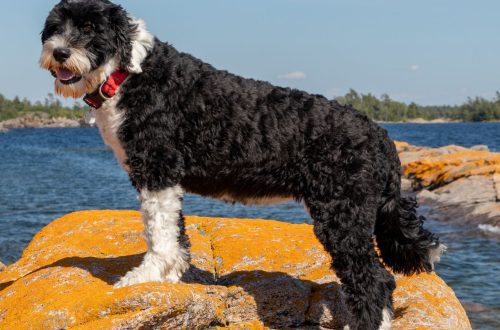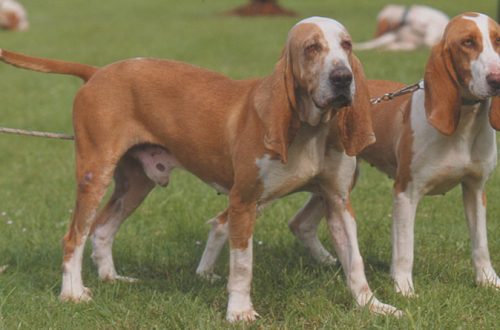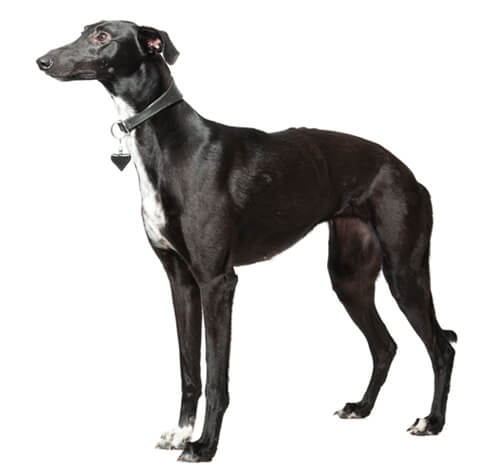
Whippet
Other names: small English greyhound
The Whippet is a graceful, smooth-haired creature with Greyhound blood in its veins. The breed was bred in the 19th century to hunt rabbits and participate in dog racing.
Contents
Characteristics of Whippet
| Country of origin | England |
| The size | Average |
| Growth | 41–50 cm |
| Weight | 12.5–13.5 kg |
| Age | up to 14 years old |
| FCI breed group | greyhounds |
Basic moments
- It is no coincidence that the name of the breed is based on the English word “whip” – a whip. In running, the animal develops maximum speed in the first seconds after the start, which resembles the sharp movements of a whip.
- Having inherited from their ancestors a passion for hunting and a persecution mania, whippets require close attention in any location outside the apartment. In pursuit of trophies, the dog forgets about everything and can get lost even on a walk.
- Incredible, but true: such a traditional disease for greyhounds as joint dysplasia, whippets bypassed.
- Whippets are very comfortable and, due to a lack of body fat, do not tolerate cold well, so you will have to be very careful in equipping a place for a pet in the house. In addition, for the cold season, the dog will need several sets of clothes for walking.
- The breed is optimally suited for hunters and people who love sports. Taking a Whippet to watch shows with him is a bad idea.
- Unlike other greyhounds, whippets are not demanding on the dimensions of housing and feel great in a typical apartment.
- The breed inherited the sprinting abilities of the Greyhound, so its representatives are often called the fastest greyhounds in the weight category up to 15 kg.
- Energetic in the conditions of the street and wildlife, at home, animals behave in a relaxed and imposing manner, preferring to comprehend Zen on sofas and armchairs.
- To appreciate the beauty and grace of the Whippet, it is better to look at him in motion. The dog’s run is so swift and perfect that it seems as if it does not touch the ground with its paws.
- The vast majority of Whippets have warm intra-breed relationships. If several greyhounds live in the house, the owner has a unique opportunity to observe such a picture every day: the whole pack is deployed in some cozy corner, forming a giant mountain of bodies and paws.
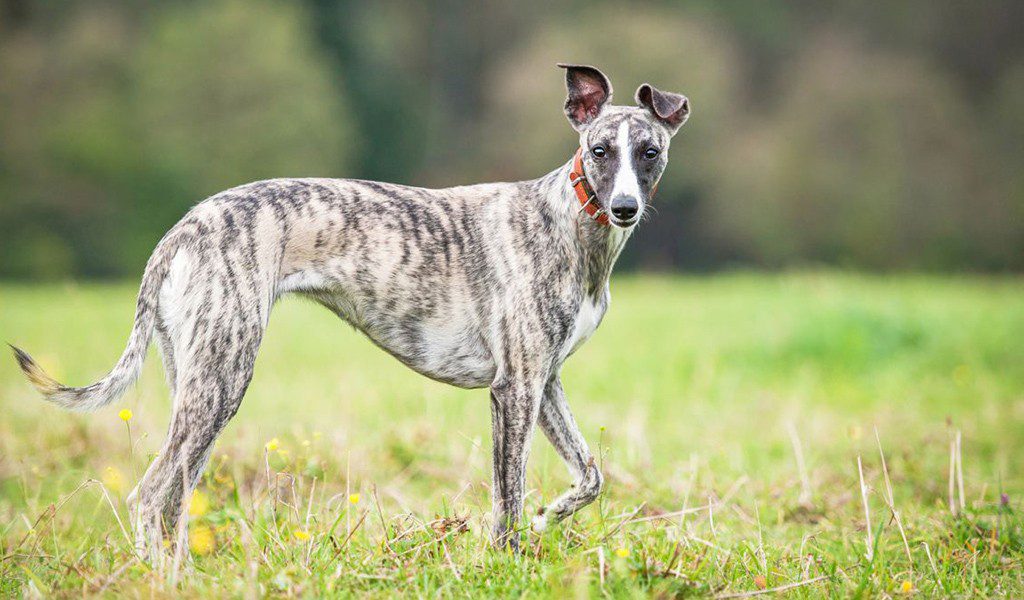
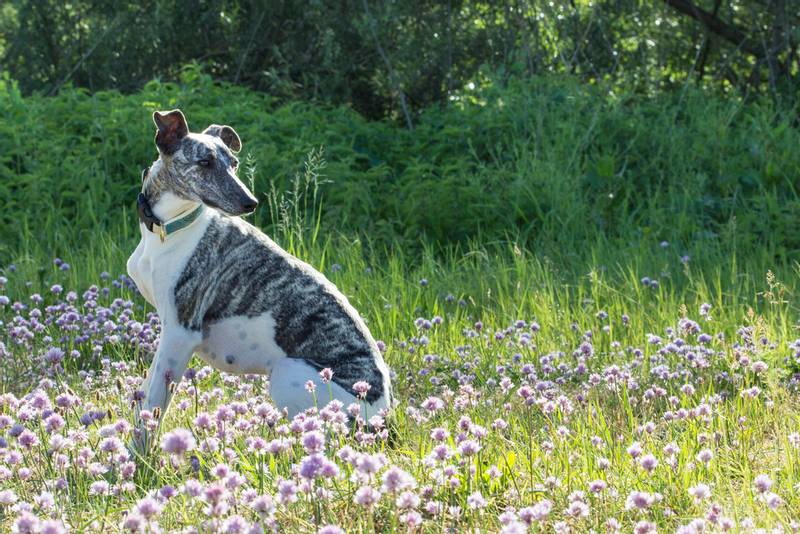
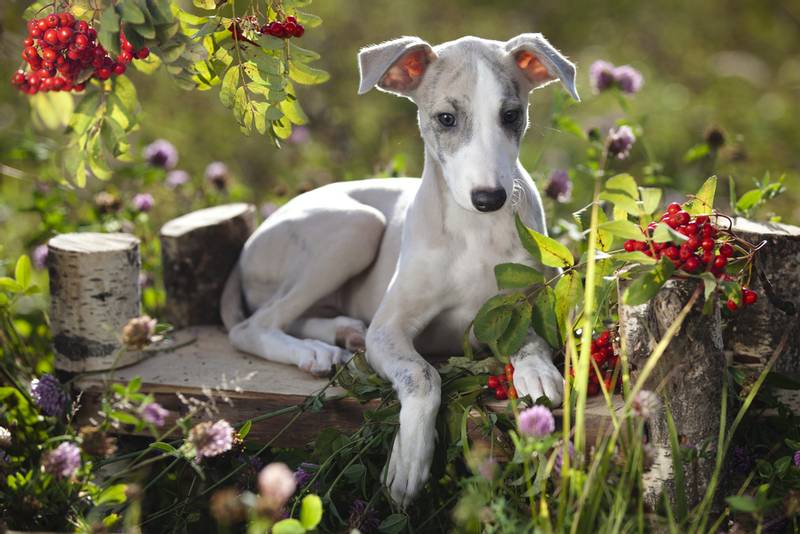
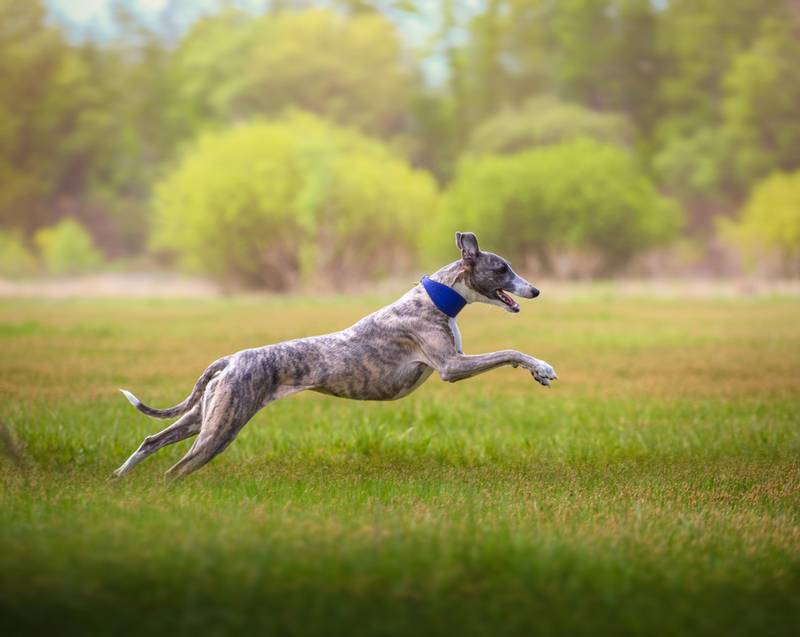
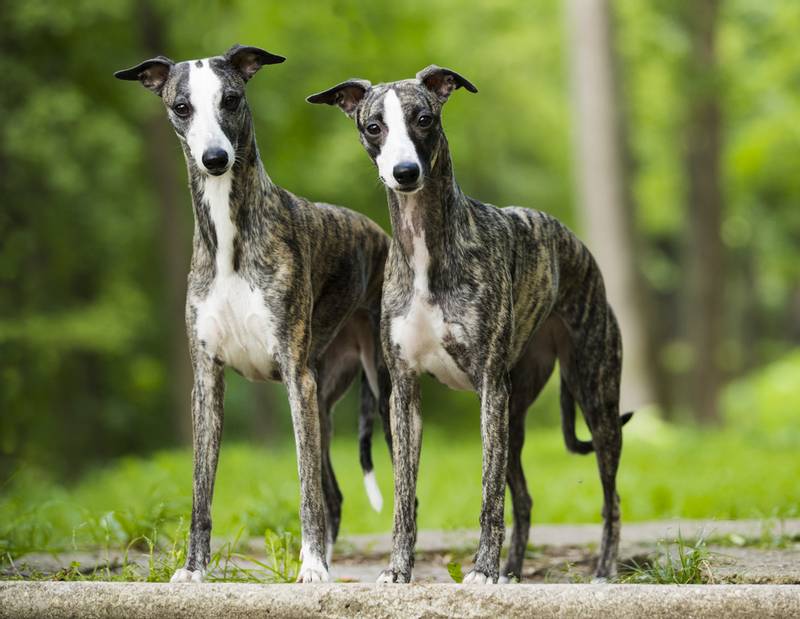
Whippet is an athlete, a skilled hunter, a sophisticated intellectual, able to decorate with his presence not only the apartment, but also the life of the owner. Despite a fairly lively temperament and love of active entertainment, the small English greyhound is not the kind of dog that will cause problems. And all because these graceful clever women intuitively understand when to turn on the turbo mode, and when it is better to merge with the interior to give the owner a little respite. At the same time, the breed is categorically not inclined to restrain its own feelings, so, bringing a tiny whippet into the house, get ready to drown in tenderness and affectionate pestering – the level of emotionality in small English greyhounds, without exaggeration, rolls over.
History of the Whippet Breed
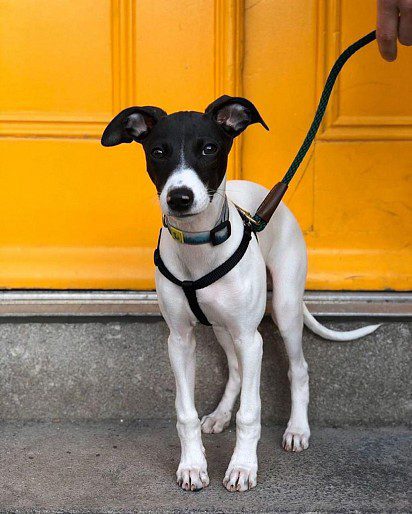
Great Britain is considered the official homeland of Whippets, although there is a lot of evidence that their ancestors have never been an aboriginal breed of Foggy Albion. So, for example, during excavations in the territories of the Roman Empire, archaeologists have repeatedly found figurines of small graceful greyhounds. This gave researchers the opportunity to assume that animals came to England with the conquerors even before the beginning of our era.
The first breed that the English received from Roman Greyhounds was the Greyhound . The maintenance of such a dog cost a pretty penny, because for a full-fledged hunt, the animal needed to be fed heartily and preferably with meat. As a result: Greyhound breeding was preferred mainly by the British nobility, who had no problems with finances.
By the 19th century, when hunting and dog racing had ceased to be the privilege of the beau monde, the working class also began to show interest in greyhounds. And since this social stratum did not like to spend money on pets, its representatives preferred to breed a new unpretentious breed, with a moderate appetite. This is how the Whippets, or “poor man’s greyhounds,” as local breeders preferred to call them, were born.
There is an opinion that the Whippets are descended from a cross between a Greyhound and a Bedlington Terrier . Allegedly, it was as a result of unscheduled mating of these two breeds that small mestizos were born, which the miners of South Wales began to breed. One way or another, by the end of the 19th century, Greyhound relatives were already on the run, hunting rabbits and other medium-sized game with their owners in their free time from racing.
In 1890, the Whippets became the persona of the grata among the British elite – the breed was finally registered by the AKC, and in 1903 it had a separate appearance standard. By the way, the hypothesis that the blood of the Italian greyhounds flows in the whippets is most likely erroneous, since in the middle of the 19th century, the Italian greyhoundsin England they were rare guests, and in the northern regions of the country they were not seen at all.
In Russia, the first owner of the whippet was Peter I. You can gawk at the effigy of the autocrat’s favorite even today if you buy a ticket to the Zoological Museum of St. Petersburg. Subsequently, the Empress Anna Ioannovna, Elizabeth and Catherine II actively supported the breed. True, over time, the hunting skills of the whippets were relegated to the background, as the animals were more often involved in companionship duties. As for the mass breeding of small English greyhounds, in our country it happened at the end of the 80s of the XX century, when about a dozen purebred puppies were purchased abroad.
Video: Whippet
Whippet breed standard
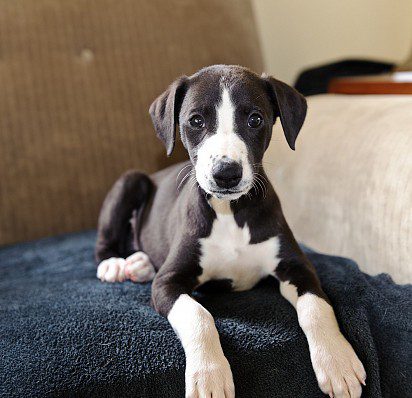
The Whippet is positioned as a link between the Greyhound and the Italian Greyhound , but he acquired an elegant physique relatively recently. As an example: the first representatives of the breed looked rough and looked like terriers. Over time, the appearance of the Whippets acquired more aristocratic features, which elevated them in the eyes of the breeders. In particular, the figures of the small English greyhounds became emphatically ascetic (the minimum amount of subcutaneous fat + short hair), and their legs were significantly lengthened and strengthened. Today’s Whippet is rather a reduced copy of the Greyhound , in which the genes of terriers are almost not guessed.
The breed standard provides for a height at the withers of 47-51 cm for males and 44-47 cm for females. The weight of dogs should be only 10-12 kg.
Head
The Whippet should have a long, flat skull, broad between the ears and tapering at the muzzle, with a slight stop.
Jaws and bite
The Lesser English Greyhound boasts strong jaws with an almost perfect scissor bite.
Nose
The classic color of the earlobe of the whippet is black. Exceptions: individuals of blue color (lobe with a blue tint), liver color (lobe of a liver shade) and dilute (any tone except pink is acceptable).
Eyes
Neat oval eyes of the dog are distinguished by a pleasant brilliance and an interested-attentive expression.
Ears
The ear cloth is soft, small, pink-shaped.
Neck
The whippet’s neck is long, well muscled, with a graceful curve.
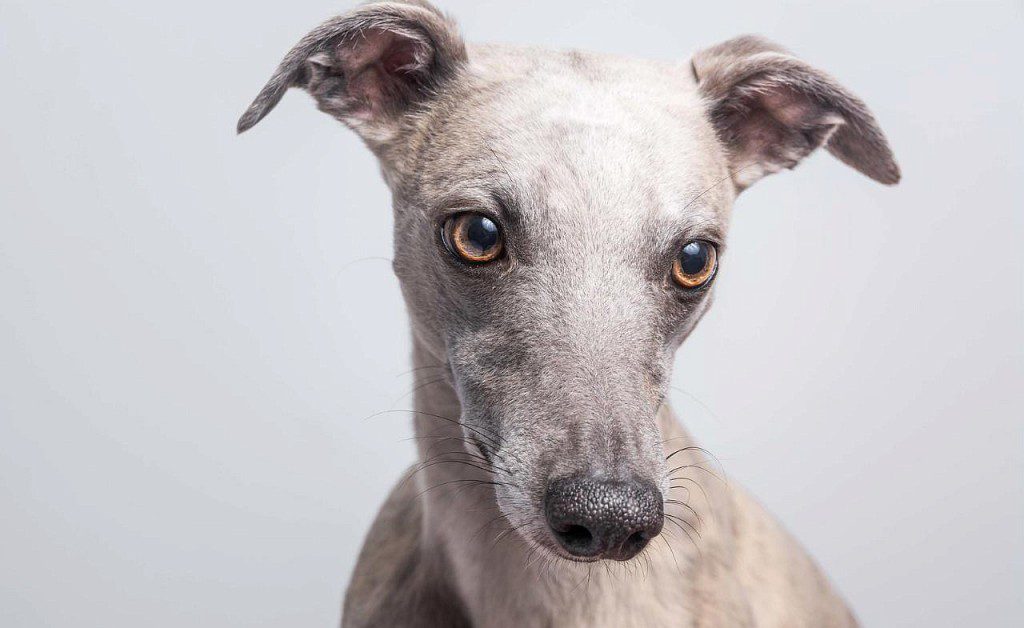
Frame
The body of the dog is harmoniously developed, with a slightly convex (not humpbacked) topline, resembling a graceful arch. A purebred Whippet should have a broad, muscular and rather long back, “reinforced” by a strong loin, as well as a deep and prominent chest.
limbs
The front legs of the Whippet are set almost vertically and not too wide. In general, the breed has the limbs of a typical hound: with oblique shoulder blades, elbows well fitting to the body and springy pasterns. The hind legs of the dog are very strong, with moderately lowered hocks, developed lower legs and wide, thickened thighs. Greyhound paws are elegant and medium-sized, ending in arched, split fingers.
The breed moves with a free light step with a low reach of the forelimbs and a deep entry under the body of the hind limbs, which provides an energetic springy push.
Tail
The whippet’s tail is long, arched, narrowed at the tip.
Wool
The smooth, short coat covers the dog’s body tightly, but does not mask minor external defects such as scars and scratches.
Color
Whippet can be of any color, but most often representatives of this breed can be found in brindle, black and gray colors.
Disqualifying vices
There can be a lot of reasons for excluding a whippet from the list of applicants for an exhibition diploma. Nevertheless, most often animals are disqualified for classic canine deformities like cryptorchidism, as well as for behavioral deviations (fearfulness, aggression).
Whippet photo
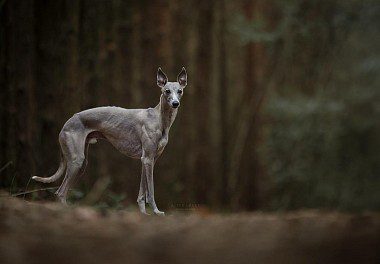
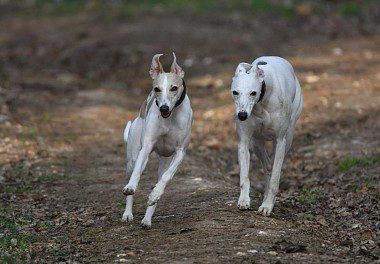
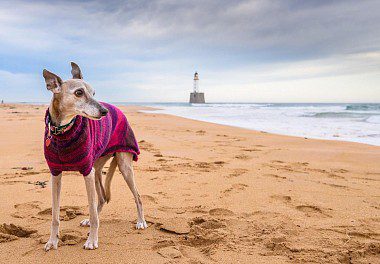
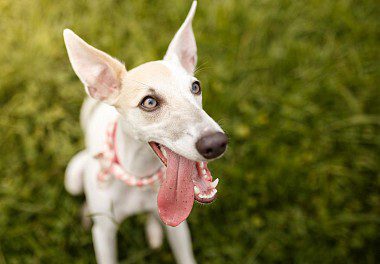
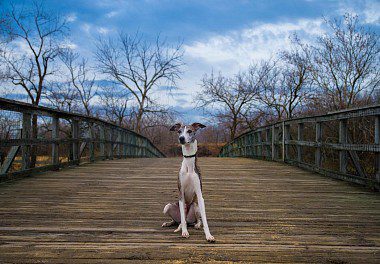
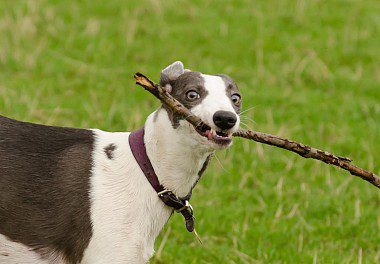
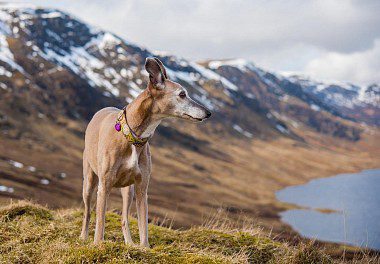
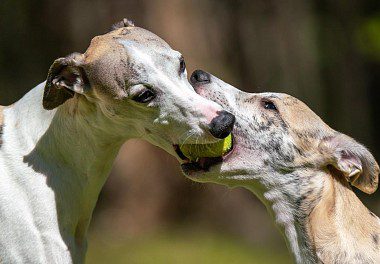
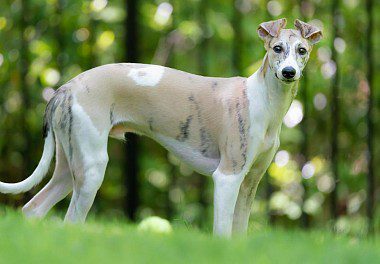
Whippet character
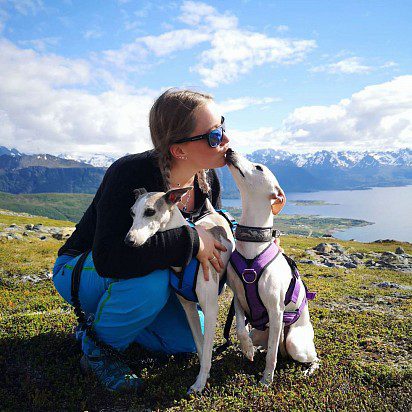
Each Whippet has its own character traits, so you can read a bunch of books about the breed, spend hours talking with breeders and kennel owners, and in the end get an animal with traits that you did not know existed. If we describe an abstract, average breed type, then usually whippets are characterized as affectionate (to the point of importunity) and loving pets. Some owners attribute psychic abilities to small English greyhounds, but this is more a myth than a reality. Of course, whippets are sensitive and attentive dogs, but they are far from full-fledged mentalists.
Attachment to the owner and an ineradicable desire to participate in all his undertakings – this is what distinguishes the breed in the first place. If you constantly trip over your pet while moving around the house, don’t get annoyed. For a small English greyhound, walking behind the owner’s tail is almost a vital necessity. But dogs do not show such love for children, therefore, as soon as the younger generation begins to go too far in pranks, the whippet stops playing and proudly retires. However, animals do not experience much hostility towards babies, and if you want to make friends between a child and a dog, explain to the first how to properly handle the animal.
Whippets manage to establish contact with other representatives of the domestic fauna without much effort. Greyhounds are especially supportive of their relatives, but if necessary, they will tolerate a cat in an apartment. At the same time, the dog clearly delimits the home territory and the rest of the world, so if the pet notices a neighbor’s cat or other medium-sized animal while walking, get ready for a furious race and a bloody fight. Everything that does not live with the Whippet in the same apartment is regarded by him as a hunting trophy.
The nightmare of every whippet is loneliness and lack of attention from the owner. Hence – destructive behavior, pogroms in the home and inadequate reactions. If a dog is talked to a lot, listened to its needs and given plenty of fun on the hunt or training ground, peaceful neighborhood and mutual understanding become quite achievable goals. Remember, the Little English Greyhound is a grateful breed, responding to a benevolent attitude with almost exemplary behavior.
Education and training
Representatives of this breed are intelligent touchy natures, and it is better to treat them delicately. Nevertheless, in the group of greyhounds, the whippet is considered the most easy-to-follow and manageable dog. Having training experience behind him, it is easy to fashion an animal not only as a tireless runner and enthusiastic hunter, but even as a responsible shepherd or obedience champion. True, without its subtleties, too, will not do. In particular, no matter how zealously the Whippet takes up his studies, he cannot achieve the diligence and diligence of a shepherd dog. Accordingly, you will have to accept the fact that any action will be performed by the dog not on the first, and sometimes not on the second request.
Despite the fragile psyche of the breed, playing along and giving in to the Whippets is not worth it if you do not want to acquire a spoiled and destructive pet. Know how to insist on your own in any situation, but without rudeness and unnecessary authoritarianism, since greyhounds have a hard time with unquestioning obedience. But the breed has no problems with memory, so the whippets quickly memorize commands from the basic UGS and OKD programs, which can be turned in their favor. So, for example, cynologists recommend not to let the dog go for walks off the leash until it starts to respond correctly to the call and learns the main rule for the breed: if the owner insists, you must return.
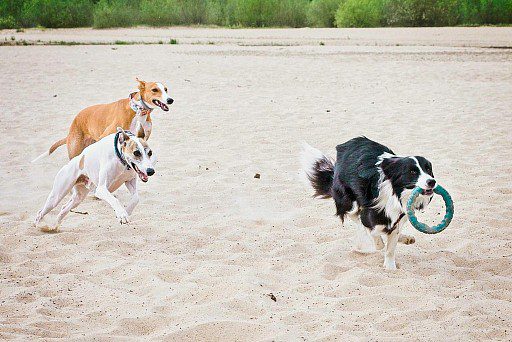
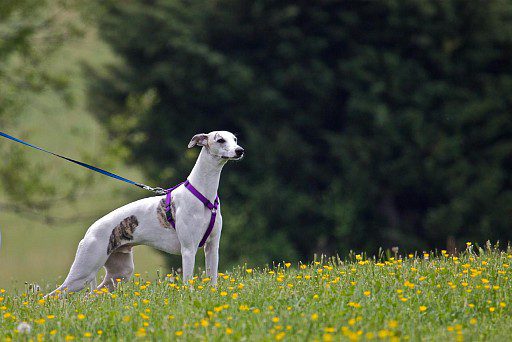
Hunting with a whippet
The main prey of the breed for hunting is rabbits and hares, but with the right training with its representatives, you can go to foxes, raccoons and other medium-sized game. Usually, the whippet’s mission is to detect a running hare, chase it, and capture it. They are not afraid of dogs and holes, so they willingly dive into any trenches. In addition, small English greyhounds are extremely jumpy, which is especially appreciated by hunters for game birds. For example, in a jump, an animal is able to take a small bird like a hazel grouse at the end. Whippets hunt solely by sight, that is, in order for the dog to lose interest in the pursued animal, it is enough just to disappear from sight. This breed either does not take a trace at all, or does it extremely unprofessionally.
Whippet dog racing
Whippet loves to run no less than to hunt, so if you are indifferent to trophies, try to find your own place in coursing with your pet. It is better to train your pet on special grounds or in natural conditions. The main thing is that the ground is flat and without asphalt. Usually two people are involved in the process: the first one holds the whippet at the start, the second moves a few hundred meters ahead, holding a bait in his hands – a pole with a tied rag or hare skin. Well, then the “launch” of the greyhound is carried out, which should race for the target. It is clear that the pet will catch up with the “pole holder” quickly, so further the trainers carry out a tricky maneuver. Wielding a stick with a bait, like a fishing rod, a person describes a circle to her, forcing the whippet to chase in a circle.
Another way to hone your running speed is by cycling accompanied by a small English greyhound. The method requires skill, as to control the speed of the animal, the owner will have to drive the vehicle with one hand, holding the leash in the second. In addition, before such a grueling test, it is necessary to allow the whippet to warm up for 5-10 minutes. Initially, the speed of the trip should be low so that the dog can run at an easy trot. The maximum acceleration is permissible only in the middle of the journey and for no more than a minute and a half, so as not to plant the heart of the whippet. Train in this way 2-3 times a week and you can count on prizes in dog racing.
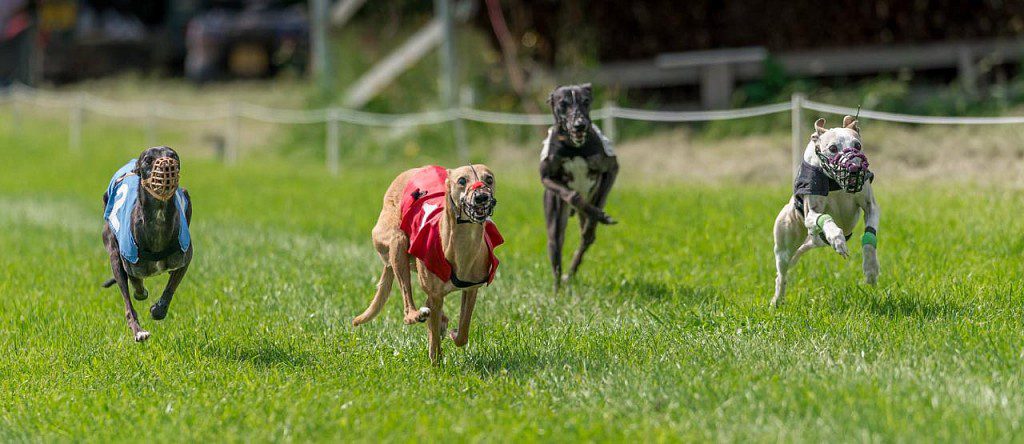
Maintenance and care
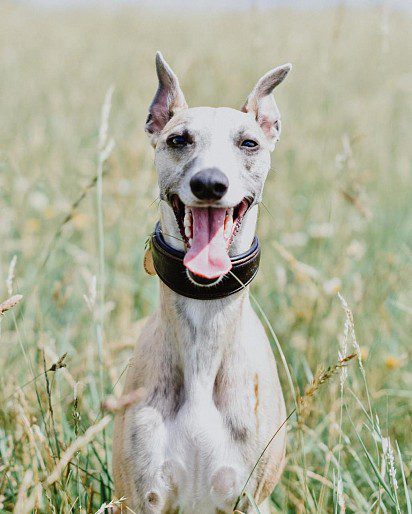
The modern whippet is not a yard dog at all, and taking it for aviary keeping means dooming the animal to illness and death. Do not forget, the Little English Greyhound has a minimal amount of body fat and a poorly warming coat, so the first draft and frost will send the pet to dog heaven. The Whippet should live in a house, and in a well-heated house, where the dog will have his own cozy corner with a soft mattress and the opportunity to lie in a chair.
In addition to a down mattress, the Little English Greyhound will need a basic wardrobe in which to go outside on cold days and bad weather. Usually this is a waterproof raincoat for walking in the rain and a couple of knitted sweaters or pajamas. Speaking of bad weather: Whippets categorically cannot stand the autumn chill and drizzle, so taking your pet out for walks in bad weather is another task. As for the fantastic physical exertion that the breed supposedly requires, then all these are horror stories of not very knowledgeable owners. In fact, the Whippet is not quite the energizer that people like to make him out to be. Yes, he is an excellent runner and hunter, but nothing more.
To walk a greyhound, you do not need to wander down the street for hours. Two visits of 40-60 minutes will be enough for the whippets to warm up and satisfy their own curiosity. The only thing you have to get used to is that the dog will constantly drag you on a leash. But this behavior is in the blood of all greyhounds, so put up with it. Runaways of whippets released from the harness are also common, so until the pet has learned to respond to the call, it will have to be walked on a leash.
Hygiene
Whippets are clean dogs that love to groom each other so that their coats hardly smell. However, exceptions to the rule also occur. If the pet smells too strongly of a dog or something worse, most likely he is unwell, or he was licked too hard by another whippet. The breed sheds seasonally, but the coat of individuals living in warm rooms can be updated unscheduled. It is easy to guess about the sudden “hair loss” by a small amount of hairs on furniture and carpeting. During this period, it is worth helping the pet and collecting dead hairs from the body with a wet rubber glove. In the intervals between molts, the Whippet does not need daily combing, but to stimulate blood circulation, it is better to brush over the pet’s skin with a brush once every 1-2 weeks.
You need to wash the small English greyhound less often. Even experienced groomers agree that if the Whippet does not have a habit of wallowing in mud and falling, 4-5 baths a year are enough for him. This approach is due to the fact that any dog cosmetics washes away the protective fatty layer from the body. And if frequent washing does not cause significant harm to breeds with a full-fledged coat, then for short-haired lean whippets, a similar procedure can cause overdrying of the skin and even alopecia. And of course, do not forget to dry the dog with a towel or hair dryer after bathing. The slightest draft on the Whippet’s damp fur and he’ll come down with a cold. In summer, the animal should be taken to the beach: greyhounds can jump into the water from the shore and race in the pond to the point of exhaustion.
The eyes and ears of the breed are trouble-free, but you still need to follow them. In the morning, slimy lumps gather in the corners of the eyelids of the whippet, which must be removed with a soft cloth soaked in chamomile infusion. Ears are cleaned once a week or two, depending on the degree of contamination. The most affordable and cheapest means to remove wax from the ear canal: soft cotton rags and hydrogen peroxide. Once or twice a month, the whippet should organize a “pedicure session”, for which you will have to stock up on special tweezers or a nail cutter.
Feeding
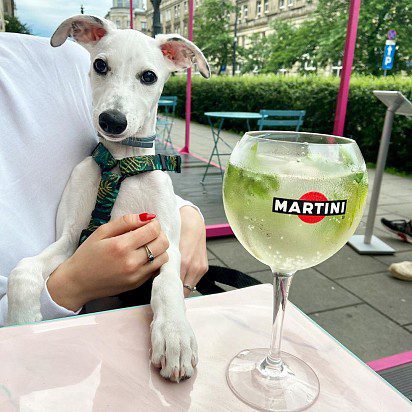
The basis of the dishes allowed to the whippet are lean meat (chicken, beef, rabbit meat), offal (tripe, heart, lung), cereals and vegetables. The serving size is calculated based on the pet’s body weight – usually it is no more than 10% of the total weight. However, if you notice that the dog is not full, put supplements in the bowl.
Of the cereals, rice, oatmeal and buckwheat are suitable for small English greyhounds, and it is better to add oatmeal to the broth or water at the end of cooking. It is useful to diversify traditional cereals with vegetables (pumpkin, zucchini, carrots). And be careful with cabbage, so as not to provoke bloating and fermentation in the stomach. If you initially put your pet on “drying”, choose super-premium food for him, containing a basic supply of vitamins and amino acids. In the case of natural nutrition, you will have to additionally buy veterinary supplements. It is not forbidden to periodically resort to proven folk remedies like vegetable oil, herbs and chicken yolk.
Important: Like any member of active breeds, Whippets are fed small meals to avoid gastric volvulus.
Starting from one and a half to two months, puppies are fed six times a day with a small English greyhound. By two or three months, the babies become stronger, so they are content with five meals a day. After another one or two months, the number of meals can be reduced to four, and at six months the Whippet puppies completely switch to three meals a day. Feeding a greyhound twice a day is recommended after she turns one year old, but individual differences must be taken into account here. There are individuals for whom the transition to an adult nutrition schedule is difficult. In such cases, it is better to stretch the three-time feeding regimen up to 14 months.
Whippet health and disease
In refined lean whippets, it is difficult to suspect big men, but that’s exactly what dogs are. There are not so many diseases that could spoil the breed’s life. In particular, small English greyhounds suffer the most from congenital deafness, various ophthalmic pathologies (cataracts, torsion / eversion of the eyelid) and von Willebrand’s disease.
How to choose a puppy
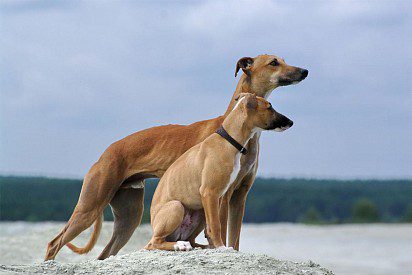
- At an early age, Whippet puppies resemble a cross between a Bull Terrier and a Staffordshire Terrier, so don’t be surprised when the kennel owner shows his wards. Over time, clumsy plump lumps will grow into graceful creatures.
- Choose a puppy with the longest (in proportion) head and barely marked stop. The sharp transition from head to muzzle indicates that, having matured, the pet will begin to look more like a terrier than a Greyhound .
- Assess the uniformity of the litter. Too much difference in size between puppies is a sign that the breeder’s producers are so-so.
- Correlate your own desires with the specialization of the nursery. Do not look for hunting whippets from show and pet dealers, and do not expect outstanding conformation from representatives of sports lines.
- The ear linen of a newborn whippet does not immediately take on a pink shape: this occurs only at 3-4 months of age. Accordingly, taking a puppy earlier than the indicated age is a certain risk.
Photo of whippet puppies
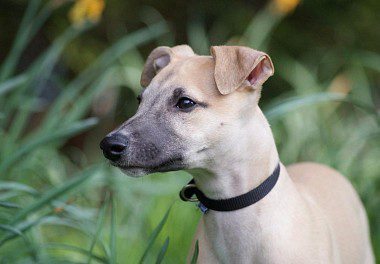
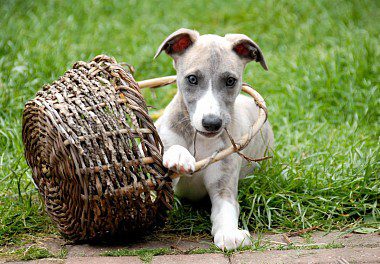
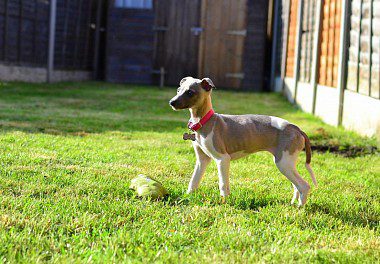
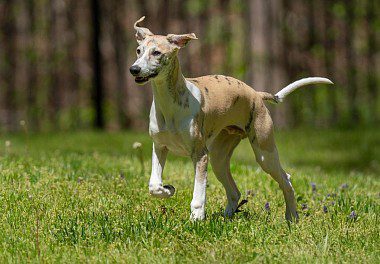
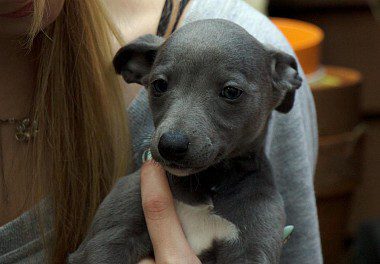
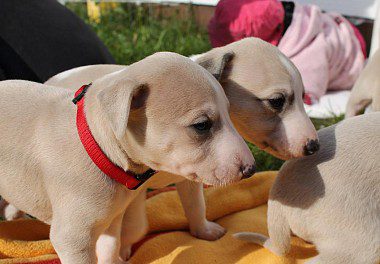
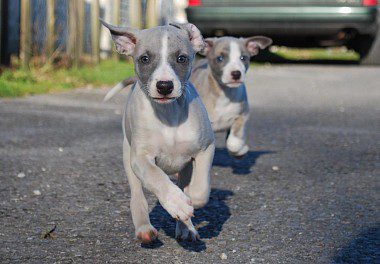
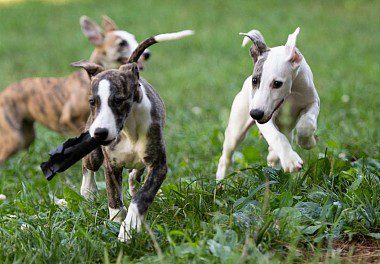
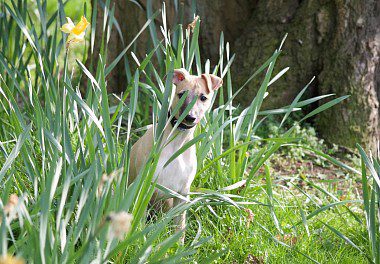
Whippet price
A whippet can cost both 250$ and 1000$. In the first case, it will be a classic pet and, perhaps, a good hunter, in the second case, it will be an elite “product” of interbreeding with an international pedigree and show prospects. By the way, you should not be afraid of such a price contrast, since the cost of most puppies in Local kennels is within 400-500$.





